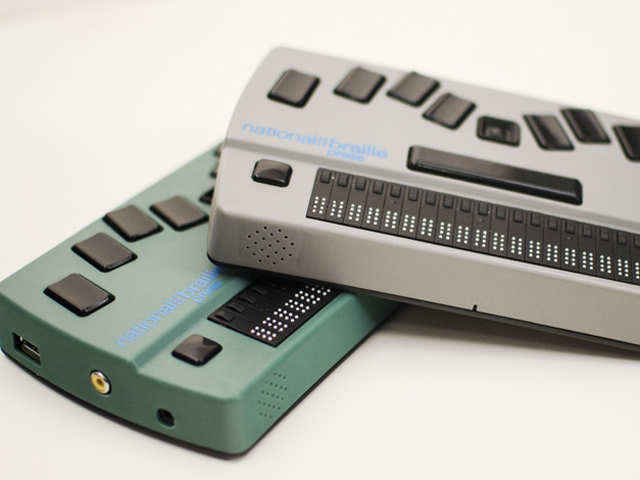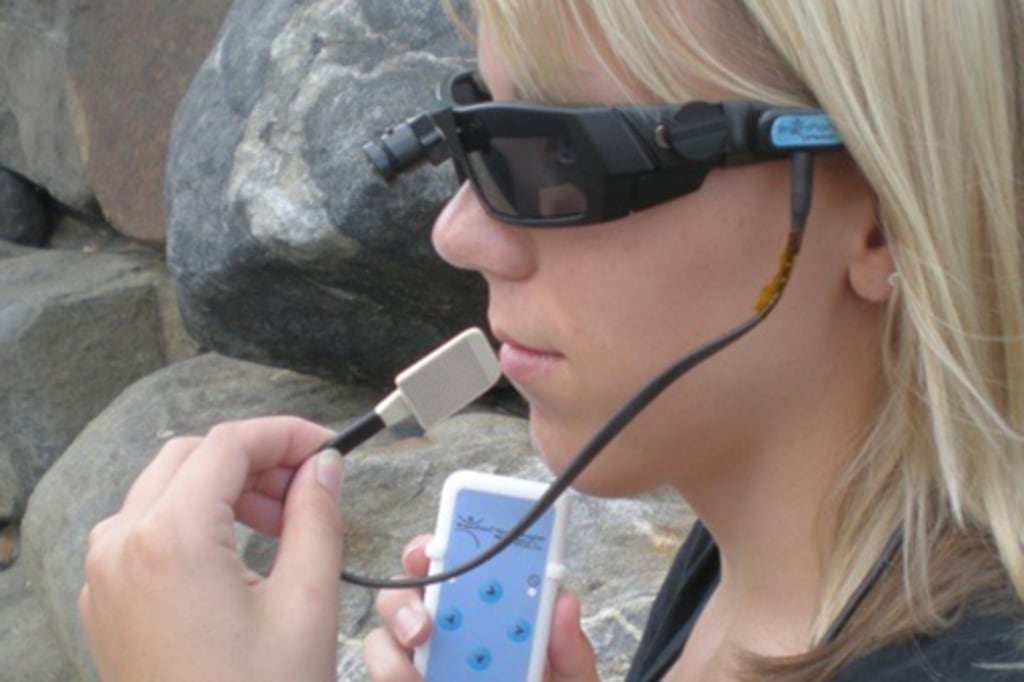Mobility Aids for Visually Impaired Users: Improving Freedom
Mobility Aids for Visually Impaired Users: Improving Freedom
Blog Article
Discover Ingenious Tools Developed for the Aesthetically Impaired
The development of cutting-edge tools for the aesthetically damaged stands for a substantial improvement in access and self-reliance. Technologies such as wise glasses with AI capacities and mobile applications made to give acoustic descriptions are improving day-to-day experiences for individuals. Furthermore, wearable tools that utilize haptic responses boost environmental understanding, while modern Braille advancements supply new means to engage with text. As these devices remain to progress, their effect on the lives of those with visual problems elevates crucial questions regarding the future of inclusivity and freedom in different elements of life. What lies ahead in this technical landscape?
Smart Glasses for Navigating

Smart glasses developed for navigating are transforming the way aesthetically impaired individuals connect with their environment. These innovative devices utilize a mix of cam technology, expert system, and auditory responses to provide real-time info regarding surroundings. By using barrier detection systems, clever glasses can inform users to prospective risks, making it possible for safer flexibility in both acquainted and unfamiliar setups.
The combination of GPS technology better boosts navigation capacities, allowing individuals to receive acoustic directions as they relocate. This hands-free strategy not only fosters independence but likewise encourages visually impaired people to browse urban landscapes with increased confidence. In addition, several wise glasses are furnished with functions that identify landmarks and street indicators, supplying contextual details that enhances the user experience.
Furthermore, the development of these gadgets is constantly advancing, with firms working to enhance the precision of item recognition and expand the variety of navigational functions. As wise glasses come to be a lot more economical and obtainable, they hold the possible to dramatically change day-to-day live for visually damaged individuals. Inevitably, these innovative tools stand for a vital action towards inclusivity, offering boosted flexibility and a greater feeling of autonomy for people browsing the world around them.

Mobile Application for Daily Living
How can mobile applications enhance the lives of aesthetically impaired individuals? Mobile applications are transforming the way visually damaged users browse their environments, handle day-to-day jobs, and access information. These applications supply essential support through numerous capabilities, promoting self-reliance and boosting lifestyle.
Numerous cutting-edge mobile applications are designed especially for everyday living. Apps like Be My Eyes connect visually damaged customers with sighted volunteers by means of video clip calls, allowing them to receive real-time help with tasks such as reviewing tags or browsing unknown rooms. In A Similar Way, Seeing AI, developed by Microsoft, utilizes expert system to define environments, reviewed message, and identify items, effectively changing a smartphone into an effective device for daily aid.
Furthermore, navigation apps customized for the visually impaired, such as Aira and BlindSquare, use audio-based directions and ecological info, enabling users to traverse their surroundings safely and confidently. Past navigation and immediate support, mobile applications likewise support organization and job monitoring, with attributes that assist users establish reminders, develop order of business, and track appointments. In recap, mobile applications serve as crucial sources, encouraging aesthetically impaired individuals to lead even more independent and fulfilling lives.
Wearable Technologies for Assistance
Empowerment through modern technology is increasingly evident in the realm of wearable tools created to help visually damaged individuals. These ingenious devices incorporate flawlessly right into every day life, enhancing navigating and supplying necessary feedback to customers. For example, smart glasses equipped with electronic cameras can read and identify faces message aloud, enabling users to engage more with confidence in expert and social setups.
An additional notable development is using haptic responses systems in wearable gadgets. These systems utilize vibrations or other responsive signals to convey information concerning the individual's setting, such as obstacles or modifications in surface, improving flexibility and safety. Wearable technologies also consist of wristbands that connect to smartphones, signaling individuals to notifications through subtle vibrations, thus improving connectivity without reliance on aesthetic cues.
As these technologies proceed to progress, they are not just improving independence for aesthetically damaged individuals yet additionally fostering a better sense of inclusion in culture. By connecting the void between difficulties dealt with in day-to-day living and the capacity for freedom, wearable modern technologies serve as critical tools in the quest for equality and empowerment for those with aesthetic problems.
Sound Description Tools
Sound description devices play a crucial duty in enhancing access for visually damaged people, supplying them with the capacity to involve with visual media. Mobility aids for visually impaired users. These tools provide narrated descriptions of vital aesthetic elements in movies, tv programs, and live performances, making sure that customers can completely comprehend the context and feelings communicated with visuals
Sound summary can be integrated into various systems, get more including streaming solutions, movie theater testings, and live cinema. Several preferred streaming solutions currently include audio summary as an availability feature, permitting viewers to pick it quickly. Along with mainstream media, specialized applications also exist, providing audio descriptions for art events, museums, and other social occasions.
The performance of audio summary depends upon the ability of the storytellers, who need to share aesthetic information succinctly without interfering with the original sound. Developments in this field are also leading the way for more tailored experiences, where individuals can change the level of detail and pacing according to their preferences.
Braille Innovations and Devices
Braille developments and devices have actually substantially changed the means visually impaired individuals communicate with message and information. Modern improvements have actually led to the development of flexible tools that improve proficiency and freedom amongst individuals.
Additionally, mobile Braille notetakers integrate traditional Braille input with modern-day performances, helping with note-taking, scheduling, and document editing and enhancing on the move. Smart glasses for the visually impaired. These small tools often include text-to-speech capacities, bridging the gap in between Braille and acoustic details
Furthermore, ingenious Braille printers have actually arised, allowing users to produce Braille tags, documents, and educational materials successfully. This access fosters greater engagement in instructional and expert atmospheres, inevitably promoting inclusivity.
Moreover, research right into clever Braille innovations continues to increase. Tools that incorporate expert system affordable eye doctor near me are being explored to offer real-time navigation help and contextual info, boosting the user experience in diverse setups. Overall, these developments show a commitment to equipping aesthetically damaged individuals via modern technology, ensuring they can quickly access and engage with the world around them.

Final Thought
The advancement of innovative tools for the visually damaged substantially enhances independence and quality of life. Smart glasses, mobile applications, wearable innovations, audio description devices, and Braille advancements jointly encourage people by offering essential navigating help, environmental recognition, and boosted reading experiences. These technologies not only foster greater addition but likewise promote autonomy in daily activities, inevitably adding to an extra accessible and equitable society for aesthetically damaged individuals. Continued development in this field clear aviator glasses holds promise for additional improvements.
As clever glasses become much more cost effective and easily accessible, they hold the prospective to substantially transform everyday life for aesthetically damaged individuals. Mobile applications are reinventing the way aesthetically impaired users browse their atmospheres, manage everyday tasks, and gain access to information. Apps like Be My Eyes link visually damaged users with sighted volunteers through video clip telephone calls, allowing them to receive real-time assistance with tasks such as reading tags or navigating strange rooms.In addition, navigation applications tailored for the visually impaired, such as Aira and BlindSquare, offer audio-based instructions and ecological information, making it possible for customers to traverse their environments securely and with confidence.The development of innovative tools for the visually impaired considerably improves independence and top quality of life.
Report this page